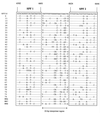Development and clinical evaluation of a highly sensitive PCR-reverse hybridization line probe assay for detection and identification of anogenital human papillomavirus
- PMID: 10405393
- PMCID: PMC85270
- DOI: 10.1128/JCM.37.8.2508-2517.1999
Development and clinical evaluation of a highly sensitive PCR-reverse hybridization line probe assay for detection and identification of anogenital human papillomavirus
Abstract
Human papillomavirus (HPV) can be detected by amplification of viral DNA. A novel PCR primer set generating a short PCR fragment (SPF PCR) was used for amplification of a fragment of only 65 bp from the L1 region and permitted ultrasensitive detection of a broad spectrum of HPV genotypes. The intra- and intertypic sequence variations of the 22-bp interprimer region of this amplimer were studied. Among 238 HPV sequences from GenBank and clinical specimens, HPV genotypes were correctly identified based on the 22-bp sequence in 232 cases (97.2%). Genotype-specific probes for HPV genotypes 6, 11, 16, 18, 31, 33 to 35, 39, 40, 42 to 45, 51 to 54, 56, 58, 59, 66, 68, 70, and 74 were selected, and a reverse hybridization line probe assay (LiPA) (the INNO-LiPA HPV prototype research assay) was developed. This LiPA permits the use of amplimers generated by the SPF as well as the MY 09/11 primers. The assay was evaluated with a total of 1, 354 clinical specimens, comprising cervical scrapes (classifications ranging from normal cytology to severe dyskaryosis) and formalin-fixed, paraffin-embedded cervical carcinoma samples. LiPA results were highly concordant with sequence analysis of the SPF amplimer, genotype-specific PCR, and sequence analysis of amplimers generated by MY 09/11 primers. The sensitivity of the SPF primers was higher than that of the GP5(+)/6(+) primers over a broad range of HPV types, especially when multiple HPV genotypes were present. In conclusion, the SPF LiPA method allows extremely sensitive detection of HPV DNA as well as reliable identification of HPV genotypes in both cervical smears and paraffin-embedded materials.
Figures



Similar articles
-
Novel short-fragment PCR assay for highly sensitive broad-spectrum detection of anogenital human papillomaviruses.Am J Pathol. 1998 Dec;153(6):1731-9. doi: 10.1016/S0002-9440(10)65688-X. Am J Pathol. 1998. PMID: 9846964 Free PMC article.
-
Comparative analysis of human papillomavirus infections in cervical scrapes and biopsy specimens by general SPF(10) PCR and HPV genotyping.J Pathol. 2001 May;194(1):51-8. doi: 10.1002/path.855. J Pathol. 2001. PMID: 11329141
-
Evaluation of a novel highly sensitive, broad-spectrum PCR-reverse hybridization assay for detection and identification of beta-papillomavirus DNA.J Clin Microbiol. 2006 May;44(5):1792-800. doi: 10.1128/JCM.44.5.1792-1800.2006. J Clin Microbiol. 2006. PMID: 16672409 Free PMC article.
-
Comparison of two PCR-based human papillomavirus genotyping methods.J Clin Microbiol. 2008 Oct;46(10):3437-45. doi: 10.1128/JCM.00620-08. Epub 2008 Aug 20. J Clin Microbiol. 2008. PMID: 18716224 Free PMC article.
-
Short fragment polymerase chain reaction reverse hybridization line probe assay to detect and genotype a broad spectrum of human papillomavirus types. Clinical evaluation and follow-up.Am J Pathol. 1999 Nov;155(5):1473-8. doi: 10.1016/S0002-9440(10)65462-4. Am J Pathol. 1999. PMID: 10550303 Free PMC article.
Cited by
-
A human papilloma virus testing algorithm comprising a combination of the L1 broad-spectrum SPF10 PCR assay and a novel E6 high-risk multiplex type-specific genotyping PCR assay.J Clin Microbiol. 2013 Apr;51(4):1171-8. doi: 10.1128/JCM.02831-12. Epub 2013 Jan 30. J Clin Microbiol. 2013. PMID: 23363835 Free PMC article.
-
Prevalence of Human Papillomavirus (HPV) Genotypes in Cervicovaginal Secretions of Human Immunodeficiency Virus (HIV) Positive Indian Women and Correlation With Clinico-Virological Parameters.Front Reprod Health. 2021 Sep 13;3:695254. doi: 10.3389/frph.2021.695254. eCollection 2021. Front Reprod Health. 2021. PMID: 36303978 Free PMC article.
-
Human papillomavirus in upper digestive tract tumors from three countries.World J Gastroenterol. 2011 Dec 28;17(48):5295-304. doi: 10.3748/wjg.v17.i48.5295. World J Gastroenterol. 2011. PMID: 22219599 Free PMC article.
-
Human papillomavirus genotyping using archival vulval dysplastic or neoplastic biopsy tissues: comparison between the INNO-LiPA and linear array assays.J Clin Microbiol. 2010 Apr;48(4):1458-60. doi: 10.1128/JCM.02311-09. Epub 2010 Feb 24. J Clin Microbiol. 2010. PMID: 20181920 Free PMC article.
-
Cervical cancer in Cape Verde: reappraisal upon referral to a tertiary cancer centre.Ecancermedicalscience. 2022 Nov 17;16:1471. doi: 10.3332/ecancer.2022.1471. eCollection 2022. Ecancermedicalscience. 2022. PMID: 36819824 Free PMC article.
References
-
- Altschul S F, Gish W, Miller W, Myers E W, Lipman D J. Basic local alignment search tool. J Mol Biol. 1990;215:403–410. - PubMed
-
- Arends M J, Donaldson Y K, Duvall E, Wyllie A H, Bird C C. HPV in full thickness cervical biopsies: high prevalence in CIN 2 and CIN 3 detected by a sensitive PCR method. J Pathol. 1991;165:301–309. - PubMed
-
- Bernard H U, Chan S Y, Manos M M, Ong C K, Villa L L, Delius H, Peyton C L, Bauer H M, Wheeler C M. Identification and assessment of known and novel human papillomaviruses by polymerase chain reaction amplification, restriction fragment length polymorphisms, nucleotide sequence, and phylogenetic algorithms. J Infect Dis. 1994;170:1077–1085. . (Erratum, 173:516, 1996.) - PubMed
-
- Bosch F X, Manos M M, Munoz N, Sherman M, Jansen A M, Peto J, Schiffman M H, Moreno V, Kurman R, Shah K V. Prevalence of human papillomavirus in cervical cancer: a worldwide perspective. International Biological Study on Cervical Cancer (IBSCC) Study Group. J Natl Cancer Inst. 1995;87:796–802. - PubMed
MeSH terms
Substances
LinkOut - more resources
Full Text Sources
Other Literature Sources
Miscellaneous

